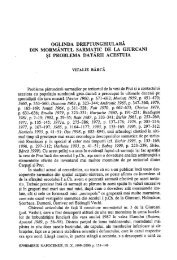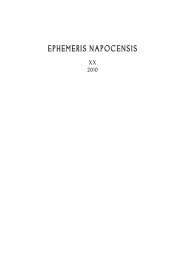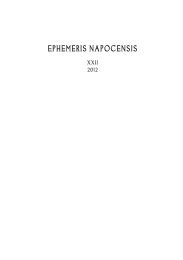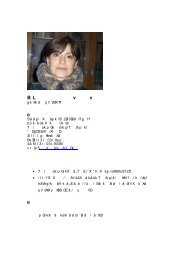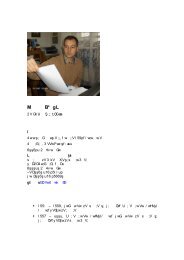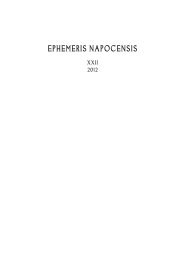ephemeris napocensis 2011 cu corectura.indd - Institutul de ...
ephemeris napocensis 2011 cu corectura.indd - Institutul de ...
ephemeris napocensis 2011 cu corectura.indd - Institutul de ...
You also want an ePaper? Increase the reach of your titles
YUMPU automatically turns print PDFs into web optimized ePapers that Google loves.
EVIDENCE FOR MEDICAL AND PERSONAL CAREIN THE CASE OF THE ROMAN ARMY IN DACIA *Monica Gui **Abstract: The aim of this study is to bring forth the evi<strong>de</strong>nce from Dacia regarding medical and personalcare in the provincial army and to highlight all the strategies adopted to counter or avert illness, while at thesame time trying to avoid too much spe<strong>cu</strong>lation or generalisation (though examples from other provinces arerecalled). First the epigraphic data will be analysed: inscriptions mentioning medical personnel, collyriumstamps, votive monuments, but also their location (medical sanctuaries, spas). The second part is <strong>de</strong>dicatedto archaeological data, both architectural (valetudinaria, thermae) and artefactual (surgical and toiletinstruments). Since the latter category is the most consistent body of evi<strong>de</strong>nce, a more refined classification isattempted, as well as,wherever possible, an exten<strong>de</strong>d dis<strong>cu</strong>ssion on context, spatial distribution and patternsin use and <strong>de</strong>position.Keywords: medical care, hygiene, surgical and toilet instruments, Roman army, Dacia.1. IntroductionThe soldiers’ health was important for the Roman army, but there are still some problemswhen it comes to how the medical service was provi<strong>de</strong>d 1 .How formal was the medical corpsorganised? Did every troop had a doctor or were there regional health care centres? Furthermore,it must be remembered that the Roman army was not permanently engaged in combat, soperhaps there was no need for a doctor in every fort, at least not on a regular basis 2 .In thinking about Roman medicine, we tend to draw a line between the more rationalaspects (i.e. surgery, the use of medical treaties) and the irrational ones (i.e. appeal togods).However, the medical offer of the day inclu<strong>de</strong>d both rational and irrational forms of treatment,sometimes in conjunction, as people could seek help from doctors or gods, visit medical sanctuariesand spas. It seems that the physicians themselves did not refuse divine help 3 , so votive*This work was possible with the financial support of the Sectorial Operational Programme for HumanResources Development 2007–2013, co-financed by the European Social Fund, un<strong>de</strong>r the project numberPOSDRU/107/1.5/S/77946 with the title ‘Doctorate: an Attractive Research Career’.**Babeș-Bolyai University Cluj-Napoca, Romania; e-mail: monica.gui@ubbcluj.ro.1For an attempt to structure the medical corps (which inclu<strong>de</strong>d medici ordinarii, capsarii, optiones valetudinarii,the miles medi<strong>cu</strong>s etc. with different duties and <strong>de</strong>grees of medical knowledge), see DAVIES 1969.2BAKER 2000, 43, 154–156.3ALLASON-JONES 1999, 142; e.g. CIL III, 3413; AE 1998, 1134; see also JACKSON <strong>2011</strong>, 246–247,251. For inscription corpora, the following abbreviations will be used: AE = L’Année épigraphique; CIL = CorpusInscriptionum Latinarum, Berlin, 1863 sqq.; IDR = Inscripţiile Daciei Romane, Bu<strong>cu</strong>reşti/I, 1975 sqq.; ILD =C. C. Petoles<strong>cu</strong>, Inscripţii latine din Dacia, Bu<strong>cu</strong>reşti, 2005; RMD = Roman Military Diplomas, London, 1978 sqq.;Tab. Vindol. = A. K. Bowman, J. D. Thomas, The Vindolanda writing-tablets, 1983 sqq.Ephemeris Napocensis, XXI, <strong>2011</strong>, p. 115–130



